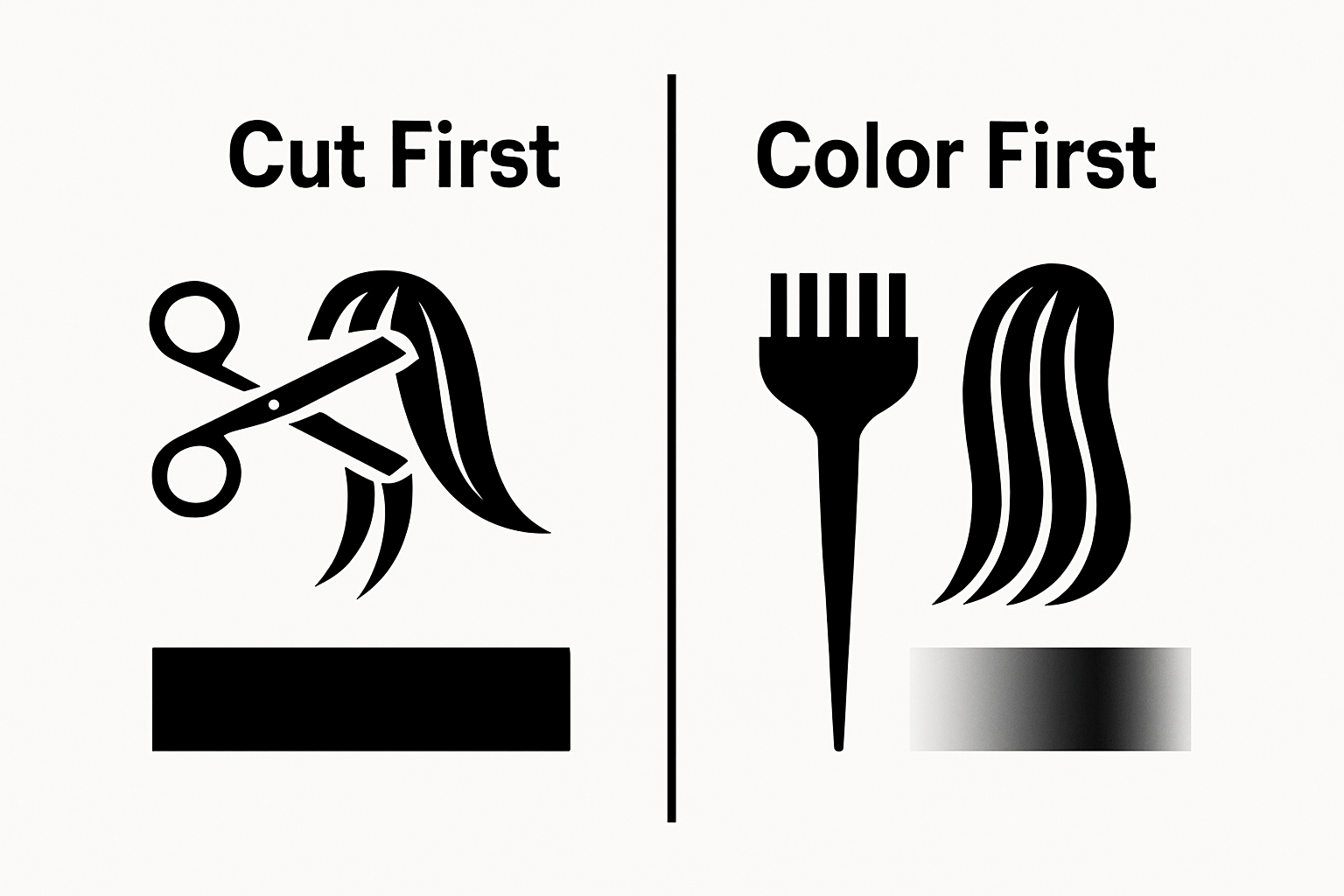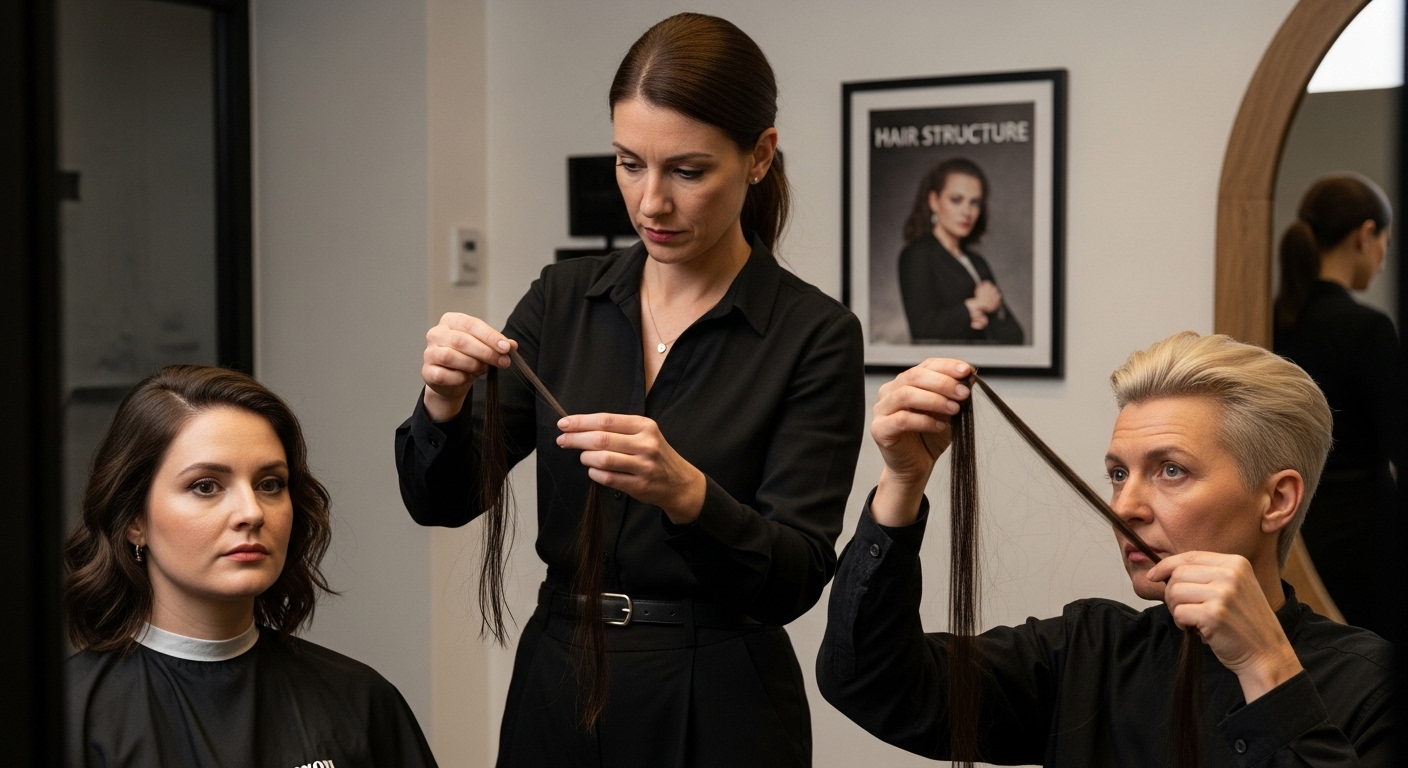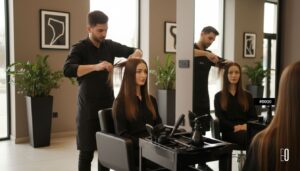Hair coloring seems simple, just a splash of new shade and a fresh cut, right? Not quite. Professional stylists know that cutting before coloring can lead to more even color and healthier hair, while the reverse can actually cause uneven shades and extra damage. Here is where most people get it wrong. The order you choose shapes everything from your hair’s health to how long that vibrant color lasts.
Table of Contents
- The Basics Of Hair Coloring And Cutting: What You Need To Know
- Why Order Matters: The Impact Of Coloring Before Cutting
- Understanding Hair Structure: How It Affects Color And Cut Decisions
- Practical Considerations: When To Cut And Color For Best Results
- Real-World Context: Professional Insights On Hair Styling Choices
Quick Summary
| Takeaway | Explanation |
|---|---|
| Cut hair before coloring for best results. | Trimming damaged ends first ensures a smoother application and protects hair integrity during coloring. |
| Consult a professional for personalized treatment. | A stylist can assess your unique hair characteristics and recommend whether to cut or color first for optimal results. |
| Consider hair porosity when choosing treatments. | Hair porosity affects how well hair absorbs color and moisture, influencing treatment decisions and outcomes. |
| Be cautious with chemical sequences. | The order of chemical treatments can impact color durability and hair health; incorrect sequences may cause uneven results. |
| Understand hair structure for effective care. | Knowledge of hair’s cuticle, cortex, and medulla can help you make informed decisions about styling and treatments. |
The Basics of Hair Coloring and Cutting: What You Need to Know
Understanding hair coloring and cutting requires more than just selecting a style or shade. These transformative processes involve complex interactions between hair structure, chemical treatments, and professional techniques. When you consider whether you should color or cut first, you need a comprehensive understanding of how these processes work and interact.
The Science Behind Hair Color
Hair color is not simply about applying pigment. According to research from the National Institutes of Health, hair dyes are categorized into several fundamental types:
- Vegetable dyes
- Mineral dyes
- Synthetic dyes (including temporary, semipermanent, and permanent variations)
Each type of dye interacts differently with your hair’s molecular structure. Permanent hair colors, for instance, penetrate the hair shaft and create lasting chemical changes. These dyes contain oxidative agents that break down the hair’s natural pigment and replace it with new color molecules.
Understanding Hair Structure and Coloration
Your hair’s ability to absorb and retain color depends on multiple factors. Hair porosity, existing damage, and previous chemical treatments significantly impact how color will look and last. Professional stylists assess these elements before recommending a specific coloring approach.
The molecular complexity of hair means that color results are never entirely predictable. Factors like natural hair pigment, underlying tone, and current hair health all play crucial roles in determining the final color outcome. This is why professional consultation is essential before making significant color changes.
Cutting and Coloring: Strategic Considerations
Deciding whether to cut or color first requires strategic thinking. While some might assume the order doesn’t matter, professionals understand that the sequence can impact overall hair health and style results. Cutting first allows stylists to create a precise shape and remove damaged ends before applying color. This approach ensures more even color application and can help protect the hair’s integrity during the coloring process.
However, in certain scenarios, coloring before cutting might be recommended. For complex color corrections or when significant length reduction is planned, the coloring process might come first to achieve the desired aesthetic outcome.
The key is working with a skilled professional who can evaluate your unique hair characteristics and design a personalized approach that maximizes both color vibrancy and hair health.
The following table compares the advantages and potential drawbacks of cutting hair before coloring versus coloring before cutting, as presented in the article.
| Treatment Order | Advantages | Potential Drawbacks |
|---|---|---|
| Cut Before Coloring | Removes damaged ends, enables even color application, protects hair integrity | May require additional touch-up if extensive color correction is planned |
| Color Before Cutting | Useful for major color corrections or big length changes | May cause uneven color distribution, potential increased damage |
Why Order Matters: The Impact of Coloring Before Cutting
The sequence of hair treatments is not merely a stylistic preference but a critical decision that can dramatically influence your hair’s health, appearance, and longevity. Professional stylists understand that the order of coloring and cutting can have profound implications for the final result.

Chemical Treatment Sequence and Hair Integrity
According to research in Cosmetics & Toiletries, the order of chemical treatments significantly affects color durability and hair health. When chemical processes are performed in an incorrect sequence, you risk:
- Uneven color distribution
- Increased hair damage
- Reduced color retention
- Potential structural weakness in hair strands
Cutting before coloring offers several strategic advantages. By trimming damaged ends first, stylists create a more uniform base for color application. This approach allows for more precise color placement and helps protect the overall hair structure during the chemical process.
Navigating Color Application and Hair Structure
The molecular complexity of hair means that each chemical treatment creates microscopic changes in the hair shaft. Permanent hair colors involve complex chemical interactions that can alter hair’s protein structure. When cutting occurs after these chemical processes, you risk:
- Losing the carefully crafted color gradient
- Disrupting the even color distribution
- Potentially creating unintended texture variations
Professional stylists carefully evaluate your hair’s current condition, considering factors like existing damage, hair porosity, and desired style before recommending the optimal treatment sequence.
Strategic Considerations for Treatment Order
While general guidelines suggest cutting before coloring, individual hair characteristics can necessitate alternative approaches. Complex color corrections or significant length reductions might require a different strategy. The key is professional assessment.
Your hair’s unique characteristics determine the most appropriate treatment sequence. Factors like hair texture, previous chemical treatments, and desired outcome all play crucial roles in deciding whether to cut or color first.
Ultimately, consultation with a skilled hair professional who understands the intricate science of hair treatments is essential. They can design a personalized approach that maximizes both your hair’s health and your aesthetic goals.
Understanding Hair Structure: How It Affects Color and Cut Decisions
Hair is far more than a simple aesthetic feature. It is a complex biological structure with intricate layers that determine how it responds to styling, cutting, and coloring treatments. Understanding these microscopic details can help you make more informed decisions about your hair care routine.
The Multilayered Composition of Hair
According to research from the National Institutes of Health, hair is composed of three primary structural layers, each playing a critical role in its overall health and appearance:
- Cuticle: The outermost protective layer
- Cortex: The middle layer containing pigment and protein
- Medulla: The innermost core (not present in all hair types)
The cuticle, consisting of overlapping keratin scales, acts like a protective shield. When these scales are smooth and intact, hair appears shiny and healthy. Chemical treatments and aggressive styling can cause these scales to lift or become damaged, making hair more porous and vulnerable to further harm.
Porosity and Its Impact on Hair Treatments
Hair porosity determines how effectively your hair absorbs and retains moisture, color, and treatments. Different porosity levels dramatically influence how your hair will react to cutting and coloring:
- Low porosity: Resistant to chemical treatments
- Medium porosity: Optimal for most hair color and cutting techniques
- High porosity: More susceptible to damage and color absorption
Protein structure within the cortex further complicates hair treatment decisions. The keratin proteins determine hair strength, elasticity, and how it responds to chemical processes. Cutting can help remove damaged protein structures, while coloring introduces new chemical interactions that can modify these proteins.
Strategic Hair Care Considerations
Professional stylists assess multiple factors beyond simple visual appearance. Hair structure analysis involves understanding:
- Natural hair texture
- Current damage levels
- Previous chemical treatments
- Individual hair strand characteristics
These insights guide decisions about whether to cut first, color first, or simultaneously address multiple hair needs.
To clarify the structure and function of hair’s layers, the table below summarizes the key characteristics of the cuticle, cortex, and medulla based on the article content.
| Hair Layer | Description | Role in Hair Health |
|---|---|---|
| Cuticle | Outermost protective layer made of keratin scales | Shields cortex, affects shine and protection |
| Cortex | Middle layer containing pigment and protein | Determines strength, elasticity, and color |
| Medulla | Innermost core (not always present) | Contributes to thickness (if present) |
The goal is always to minimize damage while achieving the desired aesthetic result.
Each hair strand tells a unique story of its environmental exposure, genetic predisposition, and previous treatments. By understanding these microscopic details, you can work with professionals to develop a personalized hair care strategy that preserves hair health while achieving your style goals.

Practical Considerations: When to Cut and Color for Best Results
Navigating the complex world of hair treatments requires strategic planning and professional insight. Your approach to cutting and coloring can significantly impact the overall health, appearance, and longevity of your hair. Understanding the nuanced interactions between these processes is crucial for achieving optimal results.
Professional Recommendations for Treatment Sequence
According to the American Academy of Dermatology, selecting the right color and treatment approach involves several critical considerations. When planning your hair transformation, you should consider:
- Choosing a color within three shades of your natural hair tone
- Protecting hair from potential UV damage
- Assessing current hair health before chemical treatments
Cutting before coloring offers distinct advantages. By trimming damaged ends first, you create a more uniform base for color application. This approach allows colorists to:
- Achieve more precise color placement
- Minimize potential color absorption variations
- Reduce overall chemical stress on hair strands
Understanding Color and Cut Compatibility
Not all hair treatments are created equal. The compatibility of cutting and coloring depends on multiple factors, including:
- Hair texture
- Current damage level
- Desired final aesthetic
- Previous chemical treatments
Professional stylists evaluate these elements to recommend the most appropriate treatment sequence. For instance, severely damaged hair might require strategic cutting before any color application to prevent further structural compromise.
Safety and Preparation Strategies
Before undertaking any significant hair transformation, professional consultation is paramount. A skilled stylist can:
- Assess your hair’s unique characteristics
- Recommend personalized treatment protocols
- Minimize potential risks of chemical damage
While home treatments might seem convenient, professional intervention ensures a more controlled and predictable outcome. The intricate balance between cutting and coloring requires expert understanding of hair’s molecular structure and individual variations.
Ultimately, your hair’s health should always be the primary consideration. By working closely with a professional who understands the science behind hair treatments, you can achieve beautiful, vibrant results while maintaining the integrity of your hair.
Real-World Context: Professional Insights on Hair Styling Choices
Transitioning from theoretical understanding to practical application requires professional expertise. Professional stylists navigate complex hair treatment decisions daily, balancing aesthetic desires with scientific precision and individual hair characteristics.
Professional Safety and Preparation Protocols
According to the U.S. Food and Drug Administration, specific safety protocols are crucial when approaching hair treatments. Professional stylists emphasize several critical preparatory steps:
- Conducting comprehensive hair and scalp assessments
- Performing patch tests to identify potential allergic reactions
- Evaluating individual hair health before chemical treatments
These preliminary evaluations help prevent potential complications and ensure the most appropriate treatment strategy. Professional intervention becomes essential when dealing with complex hair transformations that require nuanced understanding of hair structure and chemical interactions.
Client-Specific Treatment Strategies
Every hair transformation represents a unique journey. Professional stylists develop customized approaches by considering multiple interconnected factors:
- Genetic hair characteristics
- Previous chemical treatment history
- Current hair health and structural integrity
- Personal aesthetic goals
Personalization is key in modern hair styling. A one-size-fits-all approach no longer suffices in an era of sophisticated hair treatments. Professionals must blend technical expertise with creative vision to deliver exceptional results that respect individual hair uniqueness.
Navigating Aesthetic and Health Considerations
Successful hair treatments require balancing aesthetic aspirations with scientific understanding. Professional stylists act as both artists and scientists, carefully evaluating:
- Potential chemical interactions
- Long-term hair health implications
- Aesthetic outcome probabilities
- Individual hair response patterns
The most successful hair transformations emerge from collaborative dialogue between stylist and client. By understanding both technical limitations and creative possibilities, professionals can guide clients toward choices that enhance their natural beauty while maintaining hair health.
Ultimately, professional hair styling transcends simple cosmetic modification. It represents a sophisticated blend of scientific knowledge, artistic vision, and personalized care tailored to each individual’s unique hair characteristics and personal style goals.
Transform Your Hair Experience—Let Experts Guide Your Next Step
Confused about whether to color or cut first? Our article showed that the order makes a real difference for your hair’s health, color vibrancy, and final look. If you have struggled with split ends, uneven color, or simply want a professional strategy tailored to your unique hair structure and desired outcome, you are not alone. The science and artistry behind successful hair transformations require more than a quick decision. At Joel C Ma Hair Studio, every client receives the benefit of more than 25 years of expertise, coupled with truly individualized consultations based on your specific needs.

Choose to put your hair in the hands of La Jolla’s leading stylists who prioritize safety, creativity, and personalized care. Book your consultation here, where our skilled team takes you step by step through options like balayage, precision cuts, and advanced protection strategies. Discover real stories and stunning results by reading client testimonials, then explore our service menu for a preview of the luxury treatments we provide. Take action now and give your hair the expert attention it deserves at Joel C Ma Hair Studio.
Frequently Asked Questions
Should I cut or color my hair first?
Cutting your hair before coloring is often recommended as it allows for a more even color application and helps remove damaged ends, which can improve the overall health of your hair.
How does hair porosity affect coloring results?
Hair porosity determines how well your hair absorbs and retains color. Low porosity hair may resist chemical treatments, while high porosity hair may absorb color too quickly, leading to uneven results.
What types of hair dyes are available?
Hair dyes are categorized into vegetable, mineral, and synthetic types, including temporary, semipermanent, and permanent variations, each interacting differently with hair structure.
Why does the order of coloring and cutting matter?
The order of these treatments can affect hair health, color durability, and the final aesthetic outcome. Cutting first can create a more uniform base, while coloring before cutting might be necessary for complex color corrections.
Recommended
- How to Choose a Hair Color for a Stylish Transformation – Joel C Ma Hair Studio
- Understanding the Best Haircut for Face Shape – Joel C Ma Hair Studio
- Mastering Taking Care of Colored Hair for Stunning Styles – Joel C Ma Hair Studio
- Essential Hair Consultation Questions for Perfect Styles – Joel C Ma Hair Studio





